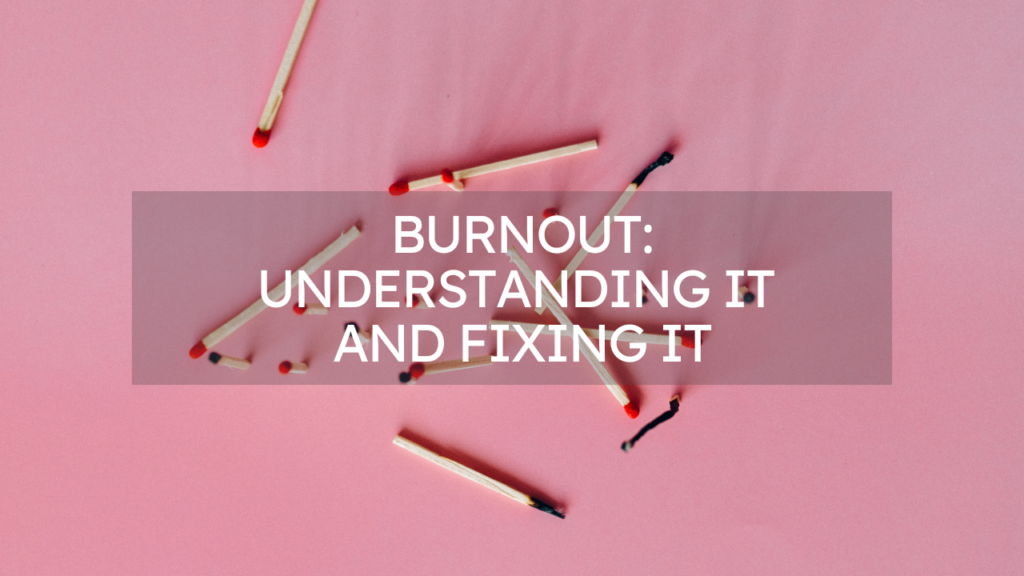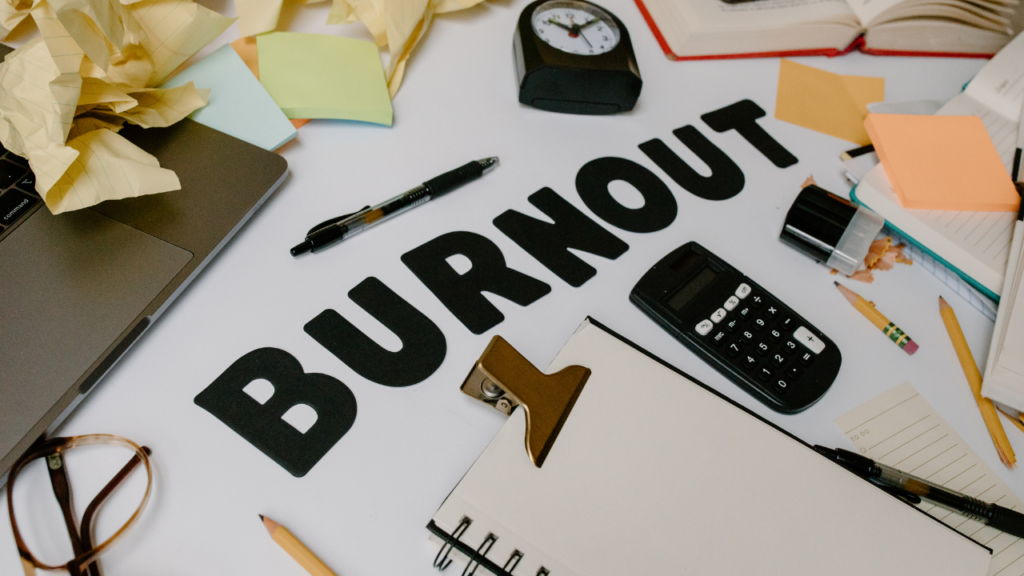Burnout: Understanding it and Fixing it
- Rick J Petronella PhD
- Aug, 20, 2024
- Newsletter
- No Comments
Dr. Rick Petronella

Burnout: Understanding it and Fixing it
In recent months and weeks, I have seen an increase in burnout, which is quite concerning. Burnout has become increasingly prevalent in recent years, reflecting the growing concern over stress in our lives and its effects on mental and physical health.
Burnout is defined as a state of emotional, physical, and mental exhaustion caused by excessive and prolonged stress. It can significantly decrease productivity, morale, and overall well-being.
Despite increased awareness and initiatives to address the issue, studies show burnout remains a widespread problem that has yet to see substantial improvement since the onset of the pandemic.

What Is Burnout?
Burnout is more than just feeling tired after among week; it is a chronic condition that results from prolonged exposure to stressors in the workplace, home, and even society. The World Health Organization classifies burnout as an occupational phenomenon characterized by three dimensions:
- Feelings of energy depletion or exhaustion.
- Increased mental distance from one’s job, family, or most close relationships or feelings of negativism or cynicism related to one’s life.
- Reduced professional and personal efficacy.
These symptoms can manifest in various ways, including physical fatigue, emotional exhaustion, and a sense of hopelessness or detachment from things in our lives. People experiencing burnout often struggle with productivity, engagement, and maintaining a healthy work-life balance.
Burnout happens when we are faced with chronic stress and lack resources, support, rest, and recovery time. Burnout is a complex phenomenon that can involve mental, physical, and emotional symptoms.
We often don’t realize that we’re suffering from burnout until it’s too late.
Signs of burnout
How do you know if you’re experiencing burnout? Here are the main symptoms.
Some common signs of Burnout
- Social isolation or a consistent lack of desire to see close family and friends
- Anhedonia: previously pleasurable activities don’t bring the same degree of pleasure anymore
- Unusual sleeping and/or eating patterns
- Colds or other illnesses that are more frequent or last longer than usual
- Negligence or hatred of caregiving duties
- Demands make it difficult to stay energized and feel effective.
- Cynicism is essentially a way of distancing yourself psychologically from your work, family, and those you love. You feel detached, negative, even callous. Cynicism can be the result of work overload and even family overload. It is also likely to occur in the presence of high conflict, unfairness, and lack of participation in decision-making. Persistent cynicism is a signal that you have lost your connection to, enjoyment of, and pride in your work or even those you love.
- Inefficacy refers to feelings of incompetence and a lack of achievement and productivity. People with this symptom of burnout feel their skills slipping and worry that they won’t be able to succeed in certain situations or accomplish certain tasks. It often develops in tandem with exhaustion and cynicism because people can’t perform at their peak when they’re out of fuel.
- Substance misuse A lack of control, An increase in self-medicating. It might be alcohol or prescription drugs; you cannot allow yourself to fall into this trap. By increasing substances only adds to the chaos and creates another issue that may even trump your burnout. Also, unrealistic expectations and role confusion can all contribute to stress and eventual burnout.
Causes of burnout
Workload. Heavy, unsustainable workloads, as well as work around the home, are a leading cause of burnout in people. Working long hours, time pressure, or too many extra responsibilities, such as being asked to do tasks we don’t have time or energy to do.

Recovery and Prevention
Prioritize self-care
It’s essential to replenish your physical and emotional energy, along with your capacity to focus, by prioritizing good sleep habits, nutrition, exercise, social connection, and practices that promote calmness and well-being, like praying or meditating, journaling, and enjoying nature. If you’re having trouble squeezing such activities into your packed schedule, give yourself a week to assess exactly how you’re spending your time.
Ways to prevent burnout
- Take care of yourself
Prioritize your physical and emotional energy by getting enough sleep, eating a balanced diet, and exercising regularly. You can also try practicing mindfulness, journaling, or meditating.
- Build a support system
Connect with friends, family, and co-workers, and ask for help when you need it. You can also try to create opportunities to connect with people at work, such as during breaks or outside of work hours.
- Set boundaries
Separate your work and personal life by turning off work notifications after hours, not checking email past a certain time, and making plans that work with your schedule.
- Take breaks
Make time to relax, clear your mind, or move your body. You can also try including enjoyable “timeouts” in your day.
- Engage in non-work activities
Make life more than just work by doing things you enjoy outside of your job and responsibilities at home. Find activities that you can look forward to engaging in.
If you recognize the signs of burnout in yourself, consider taking a few steps to ease the pressure and make your life and job manageable again.
1. Check in with yourself
Take time each day to evaluate whether your emotional and physical needs are being met and if there are steps you can take to tend to them. This will look different for everyone. Some people benefit most from rejuvenating contact with other people who can be supportive and “give” in the relationship without you always having to be the giver. Some may decide they need to re-evaluate their needs for physical rest—maybe eight hours isn’t enough during times of exceptional strain. This type of self-awareness can help you reduce burnout symptoms.
2. The Importance of Continuous Improvement
Addressing burnout is not a one-time effort but requires continuous assessment and improvement.
When life is out of balance, we feel overwhelmed and exhausted. At times, seemingly insignificant tasks—like finally taking those pants that don’t fit quite right back to the store or picking up the dry cleaning—seem insurmountable. But when life is in balance, we have more energy and peace of mind to accomplish the goals we’re striving for. Here are 10 tips to help you achieve life balance and overcome burnout.
- Put “you” on your schedule first, then schedule life’s chores afterward. Give yourself permission to honor your own needs for rest, exercise, and recreation. When you put yourself first, it’s not selfish. Everyone you care for benefits.
- Simplify your life. Do you need to Marie Kondo your life? Identifying the things that drain you and replacing them with people, activities, and things that spark joy will enhance your life balance.
- Learn to say no. Without this critical skill your time and life won’t be your own.
- Financial and emotional well-being are connected. Don’t allow yourself to think you’re trapped in debt and helpless. Face the pain of your situation and make a plan to put your finances in order.
- Identify activities that give you energy. Make sure they’re in your schedule, and you’ll find that your fatigue disappears.
- Surround yourself with high-quality relationships. Seek relationships that support, challenge, and encourage you to be balanced.
- Design a routine that allows you to accomplish what you need to get through your week smoothly. Don’t run your life in chaos and crisis mode.
- Assess the use of technology in your life. Does it decrease your stress or increase your stress? Be sure you’re managing electronic tools, not letting the tools manage you.
- Take a few minutes to relax your body. Do this at least six separate times a day. Breathe deeply. Walk outside. Stretch.
- Focus on your spiritual self and give prayer a chance. Find a quiet, still place to connect to your inner self, or allow God to be a part of this struggle. Pray for wisdom and a way to break out of this emotional state. . Practice prayer and meditation on a daily basis. Journaling can also be useful.
Burnout isn’t simply about being tired. It’s a multifaceted issue that requires a multifaceted solution. Before you quit, really think through what is contributing to your burnout and attempt to make changes. If you find that despite your best efforts, little has changed, then see if it makes sense to talk to someone. You do not have to go through this alone. This cycle cannot end by itself.
Life balance isn’t mythical, but it does take practice. Don’t get discouraged by the day-to-day chaos. Choose to focus on one or two of these tips and decide to live a more balanced and happier life.
Remember, overcoming burnout is a journey, not a destination. Be patient with yourself and celebrate small victories along the way.
Quiz: When Your Buttons Get Pushed, How Well Do You Manage Burnout?
When you have an automatic, negative response to something, this often indicates a hypersensitivity that’s referred to as “getting your buttons pushed.” Usually, these sensitivities have developed due to hurtful childhood experiences, such as repeatedly being criticized, rejected, or controlled. For example, if your parents were very controlling, when someone tells you to do something, you may resist—often subconsciously. Answer the following two sets of questions, true or false, to discover how well you manage your buttons being pushed.

Set 1
- When my buttons get pushed, I tend to shut down and withdraw.
- When someone hurts me—even when I know it was unintentional—I lash out at them or blame myself.
- I hate it when someone tells me I’m “too sensitive.”
- When someone says or does something that triggers the feelings connected to an old emotional pain, it takes me a long time to let go of it and feel centered again. I often carry a resentment.
- Sometimes I have no idea why I do what I do—I just can’t control myself.
- Once someone pushes my buttons, that’s it—my wall goes up and stays up. I feel like a powerless little kid.
Set 2
- When old feelings are triggered by something in the present, I take a deep breath, acknowledge that old feelings have been activated, get myself to a safe and comfortable environment and seek the support I need.
- Rather than feeling victimized and blaming someone for pushing my buttons, I, again, take a deep breath, and then take an honest look at myself to see what I can learn from the situation.
- I’ve worked to uncover old, painful issues so that I can release what was triggered and not feel at the mercy of my emotional response.
- When I feel triggered, it often has nothing to do with the person who pushed my buttons.
- I’m familiar with my most common “buttons”; I recognize them more quickly now and am less reactive.
- When my buttons do get pushed now, I am able to see the unresolved issues needing my attention.
- I feel like an empowered adult when I can courageously look at my emotional triggers and work through them.
If you answered true more often in Set 1 and false more often in Set 2, you may wish to learn how to deal more effectively when your buttons get pushed and how to release their charge. Please don’t hesitate to call if you’d like to explore this issue further.